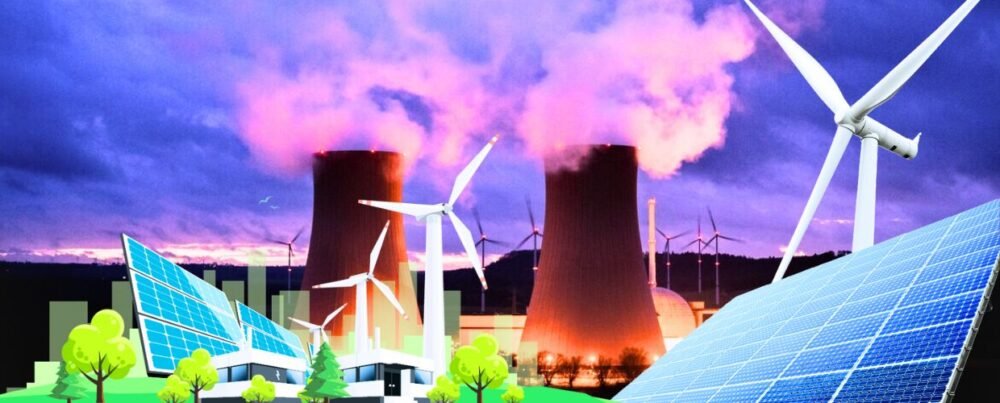Combining nuclear power with renewable energy systems has become viable in pursuing dependable and sustainable energy sources. This article explores the concept of hybrid energy systems and their role in shaping a sustainable energy future.
What are Hybrid Energy Systems?
Integrating renewable energy solutions, such as solar, wind, hydro, or biomass, with nuclear power plants is known as hybrid energy systems. These systems work together perfectly to generate energy while reducing our carbon footprint.
The primary objective of these systems is to optimize each technology’s strengths while minimizing limitations. By combining nuclear reactors’ continuous baseload power generation with renewables’ intermittent nature, hybrid systems strive to achieve a stable and environmentally friendly energy supply.
Advantages of Hybrid Energy Systems
Hybrid energy systems combine the benefits of both nuclear and renewable energy technologies and offer the potential for clean, low-carbon electricity generation. Some of them are explained below.
Enhanced Grid Stability
One significant advantage of hybrid energy systems is their ability to provide a reliable and stable power supply. While nuclear power plants offer continuous electricity production, renewables contribute to diversifying the energy mix and reducing dependence on a single source. This combination ensures a resilient grid capable of meeting varying demand patterns.
Carbon Emission Reduction
Hybrid systems play a crucial role in decarbonizing the energy sector. Nuclear power is a low-carbon energy solution, producing electricity without releasing greenhouse gas emissions. Renewable sources with hybrid systems can lead to cleaner and more sustainable electricity generation, reducing the energy system’s carbon footprint.
Resource Optimization
Integrating nuclear power with renewables optimizes the use of available resources. Nuclear reactors require relatively small land areas and provide high energy density, while renewables utilize abundant sources like sunlight and wind. The coexistence of these technologies maximizes land and resource utilization, making hybrid systems an efficient solution for meeting energy demands.
Complementarity and Flexibility
Nuclear reactors’ continuous power generation in hybrid systems can offset the intermittent nature of renewable energy sources. Excess renewable energy can produce hydrogen through electrolysis or be stored in energy storage systems for later use, enhancing overall system flexibility and reducing curtailment.
Challenges and Considerations
Though hybrid energy systems offer many benefits, they also present several challenges that should be considered carefully. Some of the challenges and considerations are given below.
Grid Integration
Integrating multiple energy sources into a unified grid system presents technical challenges. Proper grid planning and infrastructure upgrades are necessary to accommodate the variable output from renewables and maintain grid stability.
Cost and Economics
Due to the capital-intensive nature of nuclear power plants, hybrid energy systems may require substantial upfront investments. However, the long-term operational savings and environmental benefits can outweigh the initial costs, making hybrid systems economically viable in the future.
Safety and Public Perception
Nuclear power carries safety concerns that require stringent regulations and public acceptance. Addressing safety concerns and promoting public understanding of the benefits and risks associated with hybrid energy systems are vital for their successful implementation.
Policy and Regulatory Frameworks
Effective policies and regulatory frameworks are essential for supporting the deployment of hybrid energy systems. Governments need to incentivize and facilitate the integration of nuclear and renewable technologies through supportive regulations, financial mechanisms, and long-term energy planning.
Case Studies and Future Outlook
Several countries have already begun exploring hybrid energy systems as a viable solution. Countries like France, South Korea, the United States, and the United Arab Emirates are exploring hybrid energy systems to reduce carbon emissions and diversify their energy mix. For example, the UAE has integrated a nuclear power plant with a solar power facility.
The benefits of continuous baseload power generation from nuclear reactors with the intermittent nature of renewables and hybrid systems offer enhanced grid stability, carbon emission reduction, resource optimization, and flexibility. While challenges such as grid integration, cost considerations, safety, and policy frameworks exist, ongoing research and development efforts and supportive policies will help overcome these barriers.
Hybrid energy systems are expected to significantly impact achieving global sustainable energy goals. Continued technological advancements, cost reductions, and increased public acceptance will likely propel the growth of hybrid systems, fostering a transition to a more sustainable, low-carbon energy future.
Conclusion
Hybrid energy systems integrating nuclear power with renewables present a promising pathway to a sustainable energy future. By adopting a strategic and ongoing investment strategy, hybrid energy systems have the potential to become crucial players in the worldwide transition towards sustainable energy. These systems can deliver dependable and eco-friendly electricity, contributing to a cleaner future.












